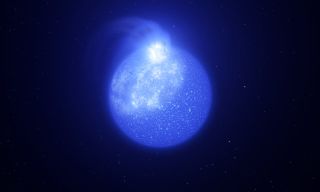Huge magnetic spots may explain weird light patterns of super-hot stars
Even stars aren't immune to spotty conditions, new research suggests.
Scientists were studying a class of fairly small, unusually hot stars that have very little hydrogen. Astronomers are interested in studying these objects because when these stars run out of fuel, something strange happens: instead of turning into red giants as most smaller stars do, they become white dwarfs, a type of stellar remnant.
"These hot and small stars are special because we know they will bypass one of the final phases in the life of a typical star and will die prematurely," Yazan Momany, lead author on the new research and an astronomer at the INAF Astronomical Observatory of Padua in Italy, said in a statement released by the European Southern Observatory, which runs the observatories used in this research.
Related: How to tell star types apart (infographic)

In particular, Momany and his colleagues focused on small hot stars found in dense clumps called globular clusters. In these neighborhoods, the scientists realized, the stars showed a weird pattern, with many of this class of star varying cyclically in brightness over time, dimming and brightening repeatedly.
The explanation they came up with relates to the magnetic fields of these stars, according to the researchers. "After eliminating all other scenarios, there was only one remaining possibility to explain their observed brightness variations," Simone Zaggia, a study co-author from the INAF Astronomical Observatory of Padua in Italy, said in the statement. "These stars must be plagued by spots!"
That terminology might sound familiar: sunspots are patches on the surface of our sun caused by knots in the star's magnetic field. But the researchers think something very different is happening on the stars they studied. On the sun, dark spots represent cool areas and are small and short-lived. On these distant stars, bright spots mark hot areas, and they can cover a quarter of the star and last for decades, according to the statement.
Get the Space.com Newsletter
Breaking space news, the latest updates on rocket launches, skywatching events and more!
The scientists even caught a few of these stars shooting out massive flares — with ten million times the energy as flares produced by our sun, according to the researchers. And scientists believe this phenomenon is also tied to the stellar magnetic fields.
That makes this research intriguing for more than these specific observations and hypotheses, the scientists say. The findings also suggest that these magnetically rooted spots could be common to a wide range of stars, even those that look very different in other ways.
The research is described in an article published June 1 in the journal Nature Astronomy.
- Know your novas: star explosions explained (infographic)
- Hubble telescope reveals what 200 billion stars look like (photos)
- New Hubble photo shows off gorgeous globular cluster
Email Meghan Bartels at mbartels@space.com or follow her @meghanbartels. Follow us on Twitter @Spacedotcom and on Facebook.
<a href="https://www.space.com/your-favorite-magazines-space-science-deal-discount.html" data-link-merchant="space.com"" target="_blank">OFFER: Save 45% on 'All About Space' 'How it Works' and 'All About History'!
For a limited time, you can take out a digital subscription to any of <a href="https://www.space.com/your-favorite-magazines-space-science-deal-discount.html" data-link-merchant="space.com"" data-link-merchant="space.com"" target="_blank">our best-selling science magazines for just $2.38 per month, or 45% off the standard price for the first three months.
Join our Space Forums to keep talking space on the latest missions, night sky and more! And if you have a news tip, correction or comment, let us know at: community@space.com.

Meghan is a senior writer at Space.com and has more than five years' experience as a science journalist based in New York City. She joined Space.com in July 2018, with previous writing published in outlets including Newsweek and Audubon. Meghan earned an MA in science journalism from New York University and a BA in classics from Georgetown University, and in her free time she enjoys reading and visiting museums. Follow her on Twitter at @meghanbartels.
-
rod The paper cited in abstract said, "For more than six decades, the quest to understand the formation of hot (about 20,000−30,000 K) extreme horizontal branch (EHB) stars in Galactic globular clusters has remained one of the most elusive in stellar evolutionary theory. Here we report on two discoveries that challenge the idea of the stable luminosity of EHB stars. The first mode of EHB variability is periodic and cannot be ascribed to either binary evolution or pulsation. Instead, we attribute it here to the presence of magnetic spots: superficial chemical inhomogeneities whose projected rotation induces the variability. The second mode of EHB variability is aperiodic and manifests itself on timescales of years. In two cases, six-year-long light curves display superflare events that are several million times more energetic than solar analogues..."Reply
Globular clusters (GCs) would be a tough place to live on an exoplanet located in the GC. The space.com report stated "Scientists were studying a class of fairly small, unusually hot stars that have very little hydrogen."
The EHB must start in the GC as ZAMS plots on the H-R diagram, and then slowly evolve into EHB stars in the GC.

